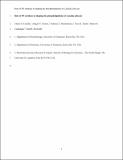Files in this item
Role of phosphatidylserine synthase in shaping the phospholipidome of Candida albicans
Item metadata
| dc.contributor.author | Cassilly, Chelsi D. | |
| dc.contributor.author | Farmer, Abigail T. | |
| dc.contributor.author | Montedonico, Anthony E. | |
| dc.contributor.author | Smith, Terry K. | |
| dc.contributor.author | Campagna, Shawn R. | |
| dc.contributor.author | Reynolds, Todd B. | |
| dc.date.accessioned | 2018-02-03T00:31:48Z | |
| dc.date.available | 2018-02-03T00:31:48Z | |
| dc.date.issued | 2017-03 | |
| dc.identifier | 250484190 | |
| dc.identifier | 886ce5d2-d907-4643-a04a-9634c41e97bb | |
| dc.identifier | 85019687523 | |
| dc.identifier | 000400577600004 | |
| dc.identifier.citation | Cassilly , C D , Farmer , A T , Montedonico , A E , Smith , T K , Campagna , S R & Reynolds , T B 2017 , ' Role of phosphatidylserine synthase in shaping the phospholipidome of Candida albicans ' , FEMS Yeast Research , vol. 17 , no. 2 , fox007 . https://doi.org/10.1093/femsyr/fox007 | en |
| dc.identifier.issn | 1567-1356 | |
| dc.identifier.uri | https://hdl.handle.net/10023/12664 | |
| dc.description | This work was supported by the National Institutes of Health NIH R01AL105690. | en |
| dc.description.abstract | Phosphatidylserine (PS) synthase (Cho1p) and the PS decarboxylase enzymes (Psd1p and Psd2p), which synthesize PS and phosphatidylethanolamine (PE), respectively, are crucial for Candida albicans virulence. Mutations that disrupt these enzymes compromise virulence. These enzymes are part of the cytidine diphosphate-diacylglycerol pathway (i.e. de novo pathway) for phospholipid synthesis. Understanding how losses of PS and/or PE synthesis pathways affect the phospholipidome of Candida is important for fully understanding how these enzymes impact virulence. The cho1Δ/Δ and psd1Δ/Δ psd2Δ/Δ mutations cause similar changes in levels of phosphatidic acid, phosphatidylglycerol, phosphatidylinositol and PS. However, only slight changes were seen in PE and phosphatidylcholine (PC). This finding suggests that the alternative mechanism for making PE and PC, the Kennedy pathway, can compensate for loss of the de novo synthesis pathway. Candida albicans Cho1p, the lipid biosynthetic enzyme with the most potential as a drug target, has been biochemically characterized, and analysis of its substrate specificity and kinetics reveal that these are similar to those previously published for Saccharomyces cerevisiae Cho1p. | |
| dc.format.extent | 8 | |
| dc.format.extent | 553080 | |
| dc.language.iso | eng | |
| dc.relation.ispartof | FEMS Yeast Research | en |
| dc.subject | Lipidomics | en |
| dc.subject | Phosphatidylserine | en |
| dc.subject | Phosphatidylethanolamine | en |
| dc.subject | Phosphatidylglycerol | en |
| dc.subject | Phosphatidylinositol | en |
| dc.subject | Phosphatidylcholine | en |
| dc.subject | Candida albicans | en |
| dc.subject | QD Chemistry | en |
| dc.subject | QH301 Biology | en |
| dc.subject | QR Microbiology | en |
| dc.subject | NDAS | en |
| dc.subject.lcc | QD | en |
| dc.subject.lcc | QH301 | en |
| dc.subject.lcc | QR | en |
| dc.title | Role of phosphatidylserine synthase in shaping the phospholipidome of Candida albicans | en |
| dc.type | Journal article | en |
| dc.contributor.institution | University of St Andrews. School of Biology | en |
| dc.contributor.institution | University of St Andrews. Biomedical Sciences Research Complex | en |
| dc.identifier.doi | https://doi.org/10.1093/femsyr/fox007 | |
| dc.description.status | Peer reviewed | en |
| dc.date.embargoedUntil | 2018-02-02 | |
| dc.identifier.url | https://academic.oup.com/femsyr/article-lookup/doi/10.1093/femsyr/fox007#supplementary-data | en |
This item appears in the following Collection(s)
Items in the St Andrews Research Repository are protected by copyright, with all rights reserved, unless otherwise indicated.

